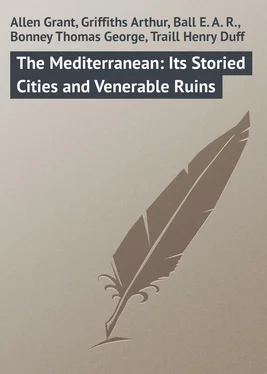E. Ball - The Mediterranean - Its Storied Cities and Venerable Ruins
Здесь есть возможность читать онлайн «E. Ball - The Mediterranean - Its Storied Cities and Venerable Ruins» — ознакомительный отрывок электронной книги совершенно бесплатно, а после прочтения отрывка купить полную версию. В некоторых случаях можно слушать аудио, скачать через торрент в формате fb2 и присутствует краткое содержание. Жанр: Путешествия и география, foreign_prose, foreign_language, на английском языке. Описание произведения, (предисловие) а так же отзывы посетителей доступны на портале библиотеки ЛибКат.
- Название:The Mediterranean: Its Storied Cities and Venerable Ruins
- Автор:
- Жанр:
- Год:неизвестен
- ISBN:нет данных
- Рейтинг книги:3 / 5. Голосов: 1
-
Избранное:Добавить в избранное
- Отзывы:
-
Ваша оценка:
- 60
- 1
- 2
- 3
- 4
- 5
The Mediterranean: Its Storied Cities and Venerable Ruins: краткое содержание, описание и аннотация
Предлагаем к чтению аннотацию, описание, краткое содержание или предисловие (зависит от того, что написал сам автор книги «The Mediterranean: Its Storied Cities and Venerable Ruins»). Если вы не нашли необходимую информацию о книге — напишите в комментариях, мы постараемся отыскать её.
The Mediterranean: Its Storied Cities and Venerable Ruins — читать онлайн ознакомительный отрывок
Ниже представлен текст книги, разбитый по страницам. Система сохранения места последней прочитанной страницы, позволяет с удобством читать онлайн бесплатно книгу «The Mediterranean: Its Storied Cities and Venerable Ruins», без необходимости каждый раз заново искать на чём Вы остановились. Поставьте закладку, и сможете в любой момент перейти на страницу, на которой закончили чтение.
Интервал:
Закладка:
Ceuta, like almost every other town or citadel on this battle-ground of Europe and Africa, has played its part in the secular struggle between Christendom and Islam. It is more than four centuries and a half since it was first wrested from the Moors by King John of Portugal, and in the hands of that State it remained for another two hundred years, when in 1640, it was annexed to the Crown of Castille. King John’s acquisition of the place, however, was unfortunate for his family. He returned home, leaving the princes of Portugal in command of his new possession; which, after the repulse of an attempt on the part of the Moors to recapture it, he proceeded to strengthen with new fortifications and an increased garrison. Dying in 1428, he was succeeded by his eldest son, Edward, who undertook an expedition against Tangier, which turned out so unluckily that the Portuguese had to buy their retreat from Africa by a promise to restore Ceuta, the king’s son, Don Ferdinand, being left in the hands of the Moors as a hostage for its delivery. In spite of this, however, the King and Council refused on their return home to carry out their undertaking; and though preparations were made for recovering the unfortunate hostage, the death of Edward prevented the project from being carried out, and Prince Ferdinand remained a prisoner for several years. Ceuta was never surrendered, and passing, as has been said, in the seventeenth century from the possession of Portugal into that of Spain, it now forms one of the four or five vantage-points held by Spain on the coast of Africa and in its vicinity. Surveyed from the neighboring heights, the citadel, with the town stretching away along the neck of land at its foot, looks like anything but a powerful stronghold, and against any less effete and decaying race than the Moors who surround it, it might not possibly prove very easy to defend. Its garrison, however, is strong, whatever its forts may be, and as a basis of military operations, it proved to be of some value to Spain in her expedition against Morocco thirty years ago. In times of peace it is used by the Spaniards as a convict station.
The internal attractions of Ceuta to a visitor are not considerable. There are Roman remains in the neighborhood of the citadel, and the walls of the town, with the massive archways of its gates, are well worthy of remark. Its main feature of interest, however, is, and always will be, that rock of many names which it thrusts forth into the Straits, to form, with its brother column across the water, the gateway between the Eastern and the Western World. We have already looked upon it in the distance from El Hacho, the signal tower on the summit of the Rock of Gibraltar. Abyla, “the mountain of God,” it was styled by the Phœnicians; Gibel Mo-osa, the hill of Musa, was its name among the Moors; it is the Cabo de Bullones of the Spaniard, and the Apes’ Hill of the Englishman. It may be well seen, though dwarfed a little by proximity, from its neighboring waters; a curious sight, if only for its strange contrast with the European Pillar that we have left behind. It is shaped like a miniature Peak of Teneriffe, with a pointed apex sloping away on either side down high-shouldered ridges towards its companion hills, and presenting a lined and furrowed face to the sea. It is its situation, as has been noted already, and not its conformation, which procured it its ancient name. But however earned, its mythical title, with all the halo of poetry and romance that the immortal myths of Hellas have shed around every spot which they have reached, remains to it for ever. And here we take our farewell look of the Pillars of Hercules to right and left, and borne onwards amidstream by the rushing current of the Straits, we pass from the modern into the ancient world.
II
ALGIERS
“A Pearl set in Emeralds” – Two distinct towns, one ancient, one modern – The Great Mosque – A Mohammedan religious festival – Oriental life in perfection – The road to Mustapha Supérieur – A true Moorish villa described – Women praying to a sacred tree – Excessive rainfall.
“Algiers,” says the Arab poet, with genuine Oriental love of precious stones in literature, “is a pearl set in emeralds.” And even in these degenerate days of Frank supremacy in Islam, the old Moorish town still gleams white in the sun against a deep background of green hillside, a true pearl among emeralds. For it is a great mistake to imagine North Africa, as untravelled folk suppose, a dry and desert country of arid rocky mountains. The whole strip of laughing coast which has the Atlas for its backbone may rank, on the contrary, as about the dampest, greenest, and most luxuriant region of the Mediterranean system. The home of the Barbary corsairs is a land of high mountains, deep glens, great gorges; a land of vast pine forests and thick, verdant undergrowth. A thousand rills tumble headlong down its rich ravines; a thousand rivers flow fast through its fertile valleys. For wild flowers Algeria is probably unequaled in the whole world; its general aspect in many ways recalls on a smaller scale the less snow-clad parts of eastern Switzerland.
When you approach the old pirate-nest from the sea, the first glimpse of the African coast that greets your expectant eye is a long, serrated chain of great sun-smitten mountains away inland and southward. As the steamer nears the land, you begin, after a while, to distinguish the snowy ridge of the glorious Djurjura, which is the Bernese Oberland of Algeria, a huge block of rearing peaks, their summits thick-covered by the virgin snow that feeds in spring a score of leaping torrents. By-and-by, with still nearer approach, a wide bay discloses itself, and a little range of green hills in the foreground detaches itself by degrees from the darker mass of the Atlas looming large in the distance behind. This little range is the Sahel, an outlier just separated from the main chain in the rear by the once marshy plain of the Metidja, now converted by drainage and scientific agriculture into the most fertile lowland region of all North Africa.
Presently, on the seaward slopes of the Sahel, a white town bursts upon the eye, a white town so very white, so close, so thick-set, that at first sight you would think it carved entire, in tier after tier, from a solid block of marble. No street or lane or house or public building of any sort stands visible from the rest at a little distance; just a group of white steps, you would say, cut out by giant hands from the solid hillside. The city of the Deys looks almost like a chalk-pit on the slope of an English down; only a chalk-pit in relief, built out, not hewn inwards.
As you enter the harbor the strange picture resolves itself bit by bit with charming effect into its component elements. White houses rise up steep, one above the other, in endless tiers and rows, upon a very abrupt acclivity. Most of them are Moorish in style, square, flat-roofed boxes; all are whitewashed without, and smiling like pretty girls that show their pearly teeth in the full southern sunshine. From without they have the aspect of a single solid block of stone; you would fancy it was impossible to insert a pin’s head between them. From within, to him that enters, sundry narrow and tortuous alleys discover themselves here and there on close inspection; but they are too involved to produce much effect as of streets or rows on the general coup d’œil from the water.
Land at the quay, and you find at once Algiers consists of two distinct towns: one ancient, one modern; one Oriental, one Western. Now and again these intersect, but for the most part they keep themselves severely separate.
The lower town has been completely transformed within half a century by its French masters. What it has gained in civilization it has lost in picturesqueness. A spacious port has been constructed, with massive mole and huge arcaded breakwater. Inside, vast archways support a magnificent line of very modern quays, bordered by warehouses on a scale that would do honor to Marseilles or to Liverpool. Broad streets run through the length and breadth of this transformed Algiers, streets of stately shops where ladies can buy all the fripperies and fineries of Parisian dressmakers. Yet even here the traveller finds himself already in many ways en plein Orient . The general look of the new town itself is far more Eastern than that of modernized Alexandria since the days of the bombardment. Arabs, Moors and Kabyles crowd the streets and market-places; muffled women in loose white robes, covered up to the eyes, flit noiselessly with slippered feet over the new-flagged pavement; turbaned Jews, who might have stepped straight out of the “Arabian Nights,” chaffer for centimes at the shop-doors with hooded mountain Berbers. All is strange and incongruous; all is Paris and Bagdad shaking hands as if on the Devonshire hillsides.
Читать дальшеИнтервал:
Закладка:
Похожие книги на «The Mediterranean: Its Storied Cities and Venerable Ruins»
Представляем Вашему вниманию похожие книги на «The Mediterranean: Its Storied Cities and Venerable Ruins» списком для выбора. Мы отобрали схожую по названию и смыслу литературу в надежде предоставить читателям больше вариантов отыскать новые, интересные, ещё непрочитанные произведения.
Обсуждение, отзывы о книге «The Mediterranean: Its Storied Cities and Venerable Ruins» и просто собственные мнения читателей. Оставьте ваши комментарии, напишите, что Вы думаете о произведении, его смысле или главных героях. Укажите что конкретно понравилось, а что нет, и почему Вы так считаете.












